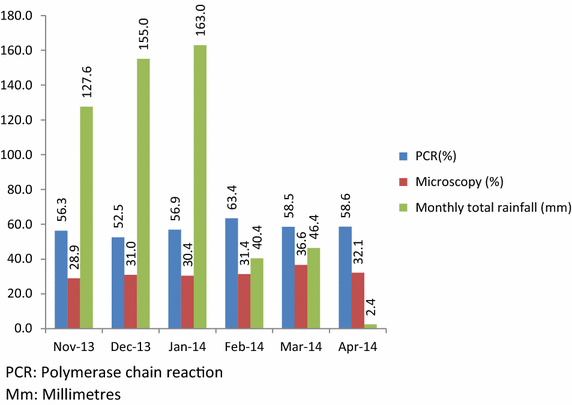High burden of malaria infection in pregnant women in a rural district of Zambia: a cross-sectional study
- PMID: 26423819
- PMCID: PMC4590700
- DOI: 10.1186/s12936-015-0866-1
High burden of malaria infection in pregnant women in a rural district of Zambia: a cross-sectional study
Abstract
Background: Malaria continues to be a major health problem in low-income countries. Consequently, malaria control remains a public health priority in endemic countries such as Zambia. Pregnant women and children under 5 years of age are among groups at high risk of malaria infection. Malaria infection is associated with adverse birth outcomes that affect the mother, foetus, and infant. Infection with HIV has been shown to increase the risk of malaria infection in pregnancy. The prevalence and the predictors of malaria infection among pregnant women resident in the Nchelenge District of northern Zambia were investigated.
Methods: Between November 2013 and April 2014, pregnant women in the catchment areas of two health centres were recruited during their first antenatal care visit. HIV testing was conducted as part of routine care. In addition, blood samples were collected from 1086 participants and tested for malaria infection using standard microscopy and polymerase chain reaction (PCR) techniques specific for Plasmodium falciparum. Multivariate logistic regression were conducted to examine the predictors of malaria infection.
Results: The prevalence of malaria identified by microscopy was 31.8 % (95 % confidence intervals [CI], 29.0-34.5; N = 1079) and by PCR was 57.8 % (95 % CI, 54.9-60.8; N = 1074). HIV infection was 13.2 % among women on their first antenatal visit; the prevalence of malaria detected by PCR among HIV-uninfected and HIV-infected women was 56.7 % (531/936) and 65.2 % (90/138), respectively. In the final model, the risk of malaria infection was 81 % higher among pregnant women recruited from Nchelenge health centre compared to those attending the Kashikishi health centre (adjusted odds ratio = 1.81; 95 % CI, 1.38-2.37, P < 0.001), and HIV-infected women across health centres had a 46 % greater risk of malaria infection compared to HIV-uninfected women (adjusted odds ratio = 1.46; 95 %, 1.00-2.13, P = 0.045).
Conclusion: High burden of malaria detected by PCR in these pregnant women suggests that past prevention efforts have had limited effect. To reduce this burden of malaria sustainably, there is clear need to strengthen existing interventions and, possibly, to change approaches so as to improve targeting of groups most affected by malaria.
Figures
References
-
- WHO . World malaria report: 2013. Geneva: World Health Organization; 2013.
-
- McGregor IA. Epidemiology, malaria and pregnancy. Am J Trop Med Hyg. 1984;33:517–525. - PubMed
Publication types
MeSH terms
Grants and funding
LinkOut - more resources
Full Text Sources
Other Literature Sources
Medical
Miscellaneous


